Comments / Questions (23)
![]() CLERT Annick wrote:
CLERT Annick wrote:
Le pouf à mailles envers décalées m'intéresse, mais j'ai peur du feutrage; de la laine polaris ; pouvez vous me conseiller une autre laine ne présentant pas ce risque, et à tricoter avec le moins de fils possibles ( d'où ma préférence entre polaris et snow). D'avance merci.
15.02.2021 - 14:06DROPS Design answered:
Bonjour Mme Clert, utilisez notre convertisseur pour découvrir les alternatives possibles - et retrouvez ici plus d'infos sur les alternatives, votre magasin DROPS saura vous conseiller si besoin, même par mail ou téléphone. Bon tricot!
16.02.2021 - 08:37
![]() Murielle Pham wrote:
Murielle Pham wrote:
Bonjour, j'ai envie de me faire ce modèle mais en laine feutrée...qu'en pensez vous ? Quelle sera sa taille ?
08.01.2020 - 21:21DROPS Design answered:
Bonjour Mme Pham, Si vous souhaitez feutrer ce pouf à la fin, il sera beaucoup plus petit, ou bien il vous faudra recalculer toutes les explications pour qu'il ait la forme/taille souhaité. Ces quelques informations sur le feutrage pourront peut-être vous aider. Bon tricot!
09.01.2020 - 09:38
![]() Ricci wrote:
Ricci wrote:
Bonjour, je voulais savoir s' il était possible de tricoter ces poufs en aiguille circulaire 60 cm. Parce que soit je ne trouve pas soit les boutiques sont en rupture de sock Je vous remercie
13.11.2019 - 14:07DROPS Design answered:
Bonjour Mme Ricci, tout à fait, on tricote ici en allers et retours, vos mailles seront juste légèrement plus serrées, mais toujours plus confortable que sur des aiguilles droites. Bon tricot!
13.11.2019 - 14:43
![]() Marie wrote:
Marie wrote:
Bonjour, Est il possible de tricoter le pouf à torsade avec des aiguilles droites. Je vous remercie de votre réponse
08.11.2019 - 13:41DROPS Design answered:
Bonjour Marie, ces 2 poufs se tricotent en allers et retours sur aiguilles circulaires, vous pouvez donc utiliser des aiguilles droites mais vos mailles seront plus serrées (attention à votre tension). Vous trouverez plus d'infos sur le tricot sur aiguilles circulaires ici. Bon tricot!
08.11.2019 - 14:21
![]() Cristina Borghetti wrote:
Cristina Borghetti wrote:
Buonasera, vorrei eseguire uno dei due pouff, voorei però usare un filato in cotone, è possibile? quale mi consigliate? dove osso trovare il down duvet necessario per l'imbottitura? grazie cristina
17.02.2017 - 16:25DROPS Design answered:
Buongiorno Cristina, questi pouff sono lavorati con dei filati troppo spessi che non hanno alternative in cotone, sono belli così proprio perché sono molto soffici. Per l'imbottitura può provare su internet o in negozi di tessuti per casa della sua zona. Buon lavoro!
17.02.2017 - 16:48
![]() Joanne wrote:
Joanne wrote:
I am unable to read the comments for this pattern. Is there some way I can view them translated into English? Also in Row 2 of the cable pouffe are all knit stitches worked into the back or just the KYOs?
24.06.2016 - 03:18DROPS Design answered:
Dear Joanne, on row 2, work only YOs twisted to avoid holes, all other sts will be worked as usual K sts. You are welcome to use any online translator to read comments in all other languages. Happy knitting!
24.06.2016 - 08:49
![]() Rebecca Prinz wrote:
Rebecca Prinz wrote:
Guten Tag, Würden Sie eher die Eskimo oder die Polaris für ein gleichmäßiges Maschenbild empfehlen? Danke :)
09.05.2016 - 16:44DROPS Design answered:
Liebe Rebecca, Sie erhalten sowohl mit Eskimo als auch mit Polaris ein sehr gleichmässiges Maschenbild.
09.05.2016 - 20:42
![]() Bente Møller wrote:
Bente Møller wrote:
Tak, havde nok lidt travl, og fik ikke læst rigtig😅
05.02.2016 - 12:52
![]() Mette wrote:
Mette wrote:
Hej Bente. Der står: Strik *1 ret, slå om*, gentag *-* 4 gange til, altså i alt 5 gange, og strik 2 masker ret i sidste maske = 12 masker. Håber det lykkes nu. Strikkehilsen fra Mette
05.02.2016 - 00:11
![]() Bente Møller wrote:
Bente Møller wrote:
Hej. Jeg kan ikke få det til at passe. Slå 6 m op. 1 ret, slå om, g.4 strik 2 ret = 10 m. Men i opskriften står der = 12 m. Og sæt et mærke i 2,4,6,8,10,12 m. Jeg er total på herrens mark😟 Mvh. Bente
04.02.2016 - 18:21
Let\'s Relax#letsrelaxpuff |
||||||||||
 |
 |
|||||||||
Knitted DROPS pouffe in garter st with cables or purl stitches in 4 strands ”Snow”. Can also be worked in 2 strand Polaris.
DROPS 163-6 |
||||||||||
|
DOUBLE YARN TIP: Use yarn from both inside and outside of the ball. When switching to a new ball, try to avoid switching both strands at the same time - to avoid a thick yarn when fastening. GARTER ST (back and forth): K all rows. 1 ridge = 2 rows K. PATTERN: See diagrams A.1 and A.2. The diagrams show all rows in pattern seen from RS. INCREASE TIP: Inc 1 st by making 1 YO, on next round K YO twisted (i.e. work in the back loop of st instead front) to avoid holes. ---------------------------------------------------------- POUFFE WITH CABLES: Worked back and forth on circular needle - READ DOUBLE YARN TIP. Cast on 6 sts on circular needle size 15 mm with 4 strands Snow or 2 strands Polaris. Row 1 (= RS): * K 1, 1 YO *, repeat from *-* 4 more times, K 2 in last st = 12 sts. Row 2: K all sts. NOTE: Always K YOs twisted on next row (i.e. work in back loop of st) to avoid holes. Insert a marker in 2nd, 4th, 6th, 8th, 10th and 12th st. Then continue in GARTER ST - see explanation above, AT THE SAME TIME inc 1 st before every st with marker (= 6 sts inc) - READ INCREASE TIP. Repeat inc on every row from RS 7 more times = 60 sts. REMEMBER THE KNITTING TENSION On next row from RS, inc 12 sts evenly = 72 sts. P 1 row from WS. Now work pattern as follows: Work A.1 (= 6 sts) 12 times in width (NOTE: No edge sts are worked due to thickness). When entire A.1 has been worked vertically, work the first 5 rows in A.1 (last row from RS). Then P 1 row from WS. Now continue in garter st until finished measurements. On next row from RS, dec 12 sts evenly by K 2 tog = 60 sts. Now insert 6 markers in the piece without working: Insert a marker in 1st st, then insert 5 markers in the piece 9 sts apart. 9 sts remain after last marker. On next row from RS dec 1 st after every marker. Repeat dec on every row from RS 7 more times = 12 sts. Now K all sts tog 2 by 2 = 6 sts. Cut the yarn but leave enough yarn for assembly. ASSEMBLY: Pull strands through remaining sts and tighten tog, tie and fasten strand without cutting (= bottom of pouffe). Sew the opening, sew in the outer loops of outermost sts with 2 strand Snow og 1 strand Polaris. Fill the pouffe as follows (it might be wise to have someone to help you to make it look nice). Place 1 duvet (of 1400 g) or 2 duvets (of 700 g on top of each other) and pull a stretch sheet over. Push the duvet into the pouffe (make sure that the sheet is facing out). Tighten tog top of pouffe. Fasten yarn tightly. ---------------------------------------------------------- POUFFE WITH DISPLACEMENT OF PURL STITCH: Worked back and forth on circular needle - READ DOUBLE YARN TIP. Cast on 6 sts on circular needle size 15 mm with 4 strands Snow or 2 strands Polaris. Row 1 (= RS): * K 1, 1 YO *, repeat from *-* 4 more times, K 2 in last st = 12 sts. Row 2: K all sts. NOTE: Always K YOs twisted on next row (i.e. work in back loop of st) to avoid holes. Insert a marker in 2nd, 4th, 6th, 8th, 10th and 12th st. Then continue in GARTER ST - see explanation above, AT THE SAME TIME inc 1 st before every st with marker (= 6 sts inc) - READ INCREASE TIP. Repeat inc on every row from RS 7 more times = 60 sts. REMEMBER THE KNITTING TENSION On next row from RS, inc 10 sts evenly = 70 sts. K 1 row from WS. Insert a marker here and measure from here. Now work pattern as follows: Work 2 sts in garter st, then work A.2 (= 6 sts) 11 times in width, 2 sts in garter st. When A.2 has been worked 1 time vertically, P sts in pattern continue to displace 1 st towards the left (seen from RS) on every row. When piece measures 16 cm from marker, work as follows: Work in garter st until finished measurements, AT THE SAME TIME on first row from RS dec 10 sts evenly = 60 sts. Now insert 6 markers in the piece without working: Insert a marker in 1st st, then insert 5 markers in the piece 9 sts apart. 9 sts remain after last marker. On next row from RS dec 1 st after every marker. Repeat dec on every row from RS 7 more times = 12 sts. Now K all sts tog 2 by 2 = 6 sts. Cut the yarn but leave enough yarn for assembly. ASSEMBLY: Pull strands through remaining sts and tighten tog, tie and fasten strand without cutting (= bottom of pouffe). Sew the opening, sew in the outer loops of outermost sts with 2 strand Snow og 1 strand Polaris. Fill the pouffe as follows (it might be wise to have someone to help you to make it look nice). Place 1 duvet (of 1400 g) or 2 duvets (of 700 g on top of each other) and pull a stretch sheet over. Push the duvet into the pouffe (make sure that the sheet is facing out). Tighten tog top of pouffe. Fasten yarn tightly. |
||||||||||
Diagram explanations |
||||||||||
|
||||||||||
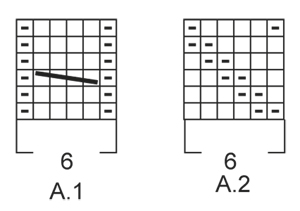
|
||||||||||
Have you finished this pattern?Tag your pictures with #dropspattern #letsrelaxpuff or submit them to the #dropsfan gallery. Do you need help with this pattern?You'll find 15 tutorial videos, a Comments/Questions area and more by visiting the pattern on garnstudio.com. © 1982-2025 DROPS Design A/S. We reserve all rights. This document, including all its sub-sections, has copyrights. Read more about what you can do with our patterns at the bottom of each pattern on our site. |
||||||||||








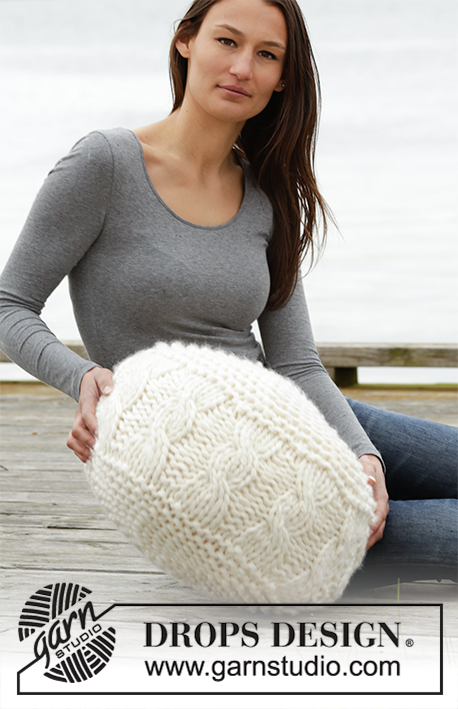
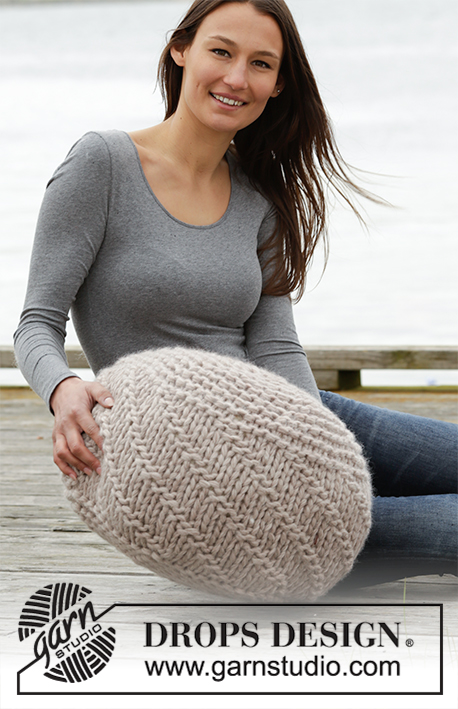


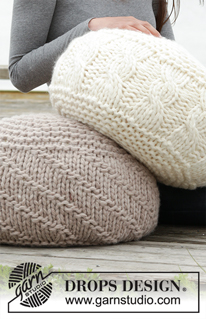












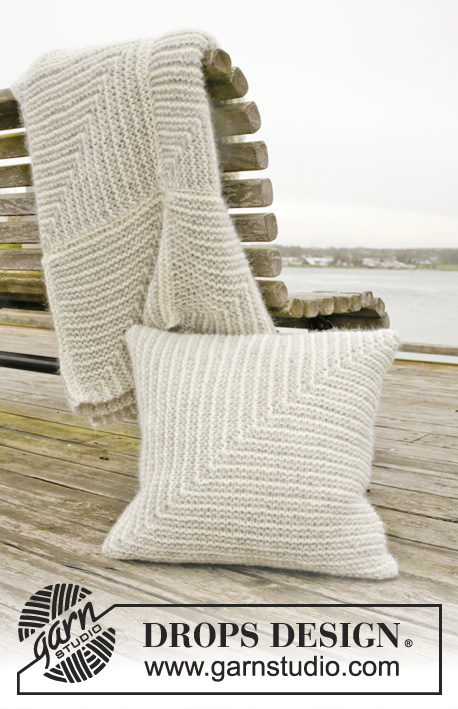





































Post a comment to pattern DROPS 163-6
We would love to hear what you have to say about this pattern!
If you want to leave a question, please make sure you select the correct category in the form below, to speed up the answering process. Required fields are marked *.